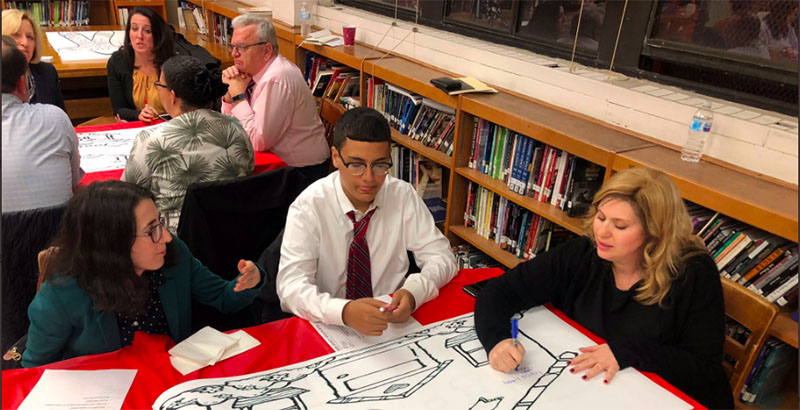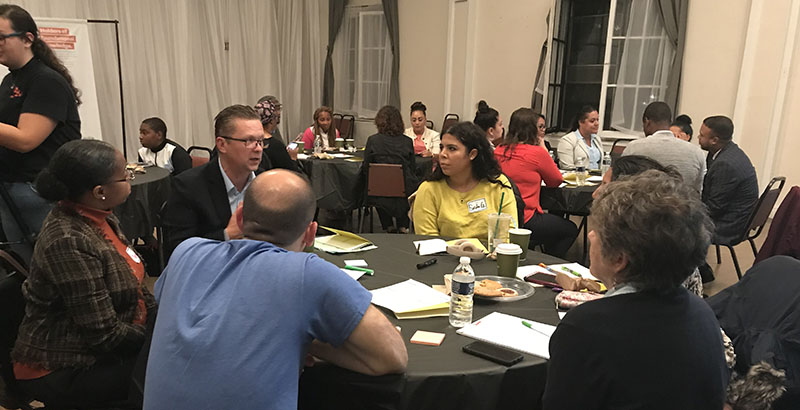Inside NYC’s ‘Imagine Schools’ Initiative: As $32M Public-Private Partnership Nears First Major Deadline, New Details Emerging About Effort to Create (and Recreate) City Schools

Tuesday marks the first deadline for New York City’s largest schools expansion effort under Mayor Bill de Blasio’s administration. But even as the next phase begins, details on logistics, timelines and vision remain somewhat abstract for the private-public partnership that seeks to create 20 new innovative high schools and reimagine 20 existing schools in the country’s largest school district.
District officials last month invited educators, students, parents and the broader community to form teams and craft “innovative” designs for these future schools as part of the $32 million Imagine NYC Schools challenge announced Oct. 3 by the mayor and Schools Chancellor Richard Carranza. After a competitive process, the 40 new or reconfigured schools will open across the five boroughs starting in fall 2021. The DOE is receiving $16 million in private funding and outside counsel from XQ, Laurene Powell Jobs’s effort to promote high school innovation nationwide, and Robin Hood, a long-standing, Wall Street-backed foundation that combats poverty.
Nov. 12 is the first deadline for interested teams to submit “statements of intent” that tell the DOE, “This is who we are, this is who we’re going to be … [and] this is the big idea that we’re working with,” Karin Goldmark, the education department’s deputy chancellor of school planning and development, told the audience at an October information session.
The first round of design team winners will be announced in May 2020. But what happens in the meantime — what it means if a team misses the Nov. 12 deadline, how applications will be reviewed and what selected teams can expect next — is more opaque.
This community-driven process is a first for New York City and its 1.1 million students and more than 1,700 schools. Charting a new way to create or re-create schools can be “messy” and “iterative,” Goldmark said last month. She had added later to The 74 that the directives for the project are purposely more open-ended so that communities “really drive the process.”
But for those like fifth-grade math teacher Nekia Williams, more information could, in fact, be helpful.
“I am optimistic about this whole thing, but I hope that there’s some type of organization,” said Williams, who teaches in District 11 in the northeast Bronx. “I hope that they already have in their minds what they’re expecting from these new schools.”
‘You want to get started’
If a team doesn’t submit a statement of intent by Nov. 12, it’s not out of luck. The DOE has confirmed that there will be subsequent application rounds, adding in an email Thursday that “exact dates of these rounds will be announced in the near future.”
The Nov. 12 deadline is the cutoff for teams that want a chance at joining the initiative’s first “design days” process in December. This months-long exercise, which will run into early February, will be inspired by XQ’s own design days model — six to seven full-day sessions where teams complete various benchmarks in developing their school plans, such as surveying the community on their design ideas and analyzing student data to deepen their understanding “of the school community’s challenges and opportunities for growth,” an XQ spokeswoman said. Teams during this time will have access to professional development and support. There will be another selection round after that where a smaller set of chosen teams will progress to additional design days, according to the DOE.
“The design process is community-driven, which takes time. It’s really rigorous, which takes time,” Goldmark said. “You want to get started.”
Not everyone who applies by Nov. 12 will make it to design days, though. “Our goal is not to narrow a lot, but we will be narrowing” the applicant pool, Goldmark told The 74. The department was unable to provide an estimate on the number of teams that had applied leading up to Tuesday’s deadline. The design day process at its limit can host up to 150 teams — and even then, “it’s not our goal to have that many,” Goldmark said. It’s unclear if that means up to 150 teams could be accepted from this first deadline pool alone, or if that cap considers future rounds too.
Teams moving forward will be notified before the beginning of December, the DOE said.

What’s also been fuzzy about this next phase of the initiative is who will be looking at the teams’ applications, and what factors will determine which ones are green-lit.
The group reviewing the submissions is “expected to include students, parents, business and industry leaders, higher education representatives, former or current principals, representatives from community-based organizations, our partners and DOE staff,” the department spokeswoman said. This kind of collaborative framework is what helped win over United Federation of Teachers President Michael Mulgrew, who said the DOE approached him in the spring about whether the union would be supportive if it took on private partners to create, or re-create, schools. He agreed that the UFT could be, as long as this was different from past efforts in which outside partners, in Mulgrew’s view, held too much sway.
“They [DOE officials] said they wanted to engage the stakeholders. I said if you want to do that, we will work with you hand-in-hand in partnership. Because if we talk to a community ahead of time and really get them excited and engaged about this school that they’re getting, that school has a much better chance of being successful right off the bat,” Mulgrew told The 74. “But let’s be clear — there’s no strings attached.”
XQ and the DOE co-creators
Although the DOE has final say over which design ideas move forward and ultimately materialize, XQ and Robin Hood do “get input on the schools that they are funding supports [to],” Goldmark said.
XQ is contributing $10 million for up to 10 new or revamped high school plans. Robin Hood is putting $5 million toward as many as 10 new schools across grade levels and $1 million toward professional development.
Nicole Campbell, XQ’s senior director of state and local partnerships, said XQ and the DOE have been co-creating a rubric that reviewers will consult as they evaluate design team ideas for the prospective high schools XQ is backing. The education department has also promoted XQ resources as guidance for design teams. “For us, what’s been really exciting is being able to show schools what different models look like,” Campbell said.
XQ is a driving force in the high school innovation realm: It’s committed $136 million to 19 design teams since 2016 to “rethink high school” through its Super School Project. Results have been mixed, though; some of those schools have faced major setbacks, with three not opening or expanding as planned and a fourth closing earlier this year.
Asked about lessons learned heading into Imagine NYC Schools, Campbell emphasized the importance of fostering “deep community partnership and deep partnership across the board [for these new schools] … from the beginning.”
Robin Hood declined to answer questions about its role in the initiative, though it looks forward “to working closely with the Department of Education on the rigorous selection process to choose new school designs and principals with the greatest promise of closing opportunity and achievement gaps for underserved students,” CEO Wes Moore said in a statement to The 74.
Looking for student engagement
While the education department has been reluctant to expound on what it personally considers a “strong” design plan, there have been some glimpses into its thinking.
At the October session, Goldmark encouraged teams to think “outside the box.” That could mean envisioning a school that caters to a certain underserved population, or specializes in a particular subject area, like technology or art, or adopts nontraditional methods of instruction, like real-world learning through internships and community projects. Although locations for the future NYC schools are not yet known, teams are allowed to tailor their ideas for a particular community of interest as well.
The department is also looking for teams to engage students in ways “that go beyond participating on the design team,” Goldmark told The 74.
If a design team is proposing an elementary school, for example, “You might prototype a learning experience for kindergartners and see what they do with that learning experience” and then use that feedback in the design plan, she said.
Getting these types of insights is what brought universal-literacy coach Bianca Jackson to the information session in the first place.
“I wanted to feel out the different mindsets that are represented by all the people here, and hopefully get some new ideas on how to implement — how to take it from the idea stage to the implementation stage,” said Jackson, who works at an elementary school in District 9, home to Yankee Stadium.
Mulgrew said he embraces the district’s approach of first asking the community what it wants to see in a new school after “decades [when] New York City would build a school and tell the community, ‘Here’s a school and this is what it’s doing.’” Beyond that, the union leader said the design teams do need guidance.
“Part of this has to be giving people some ideas and options. Because especially if you’re not a teacher, you might not know. And even if you are a teacher, you might not know about the different ways and different ideas that people have out there that —when implemented properly — have proven to be successful.”
Get stories like these delivered straight to your inbox. Sign up for The 74 Newsletter

